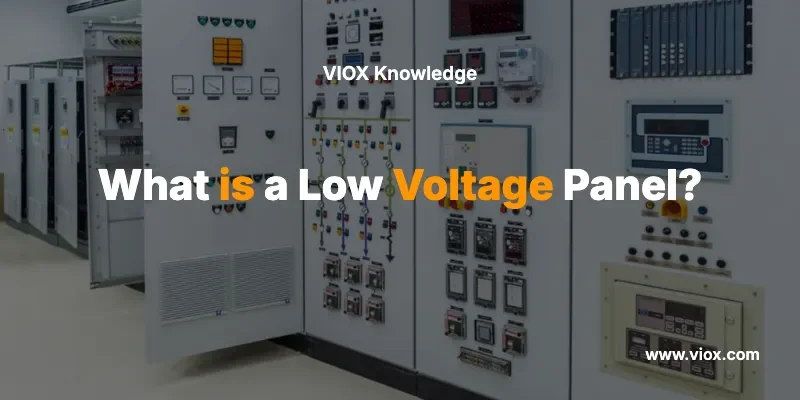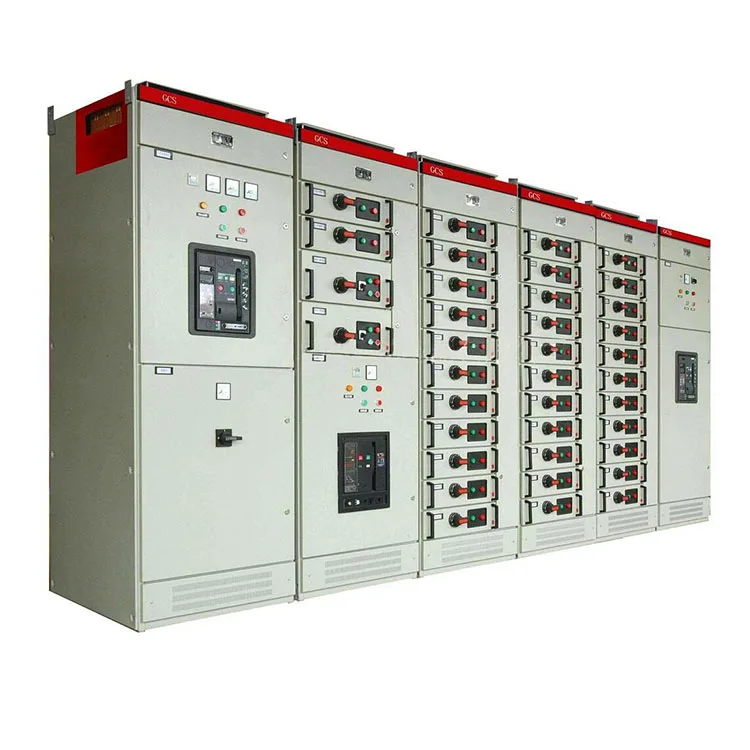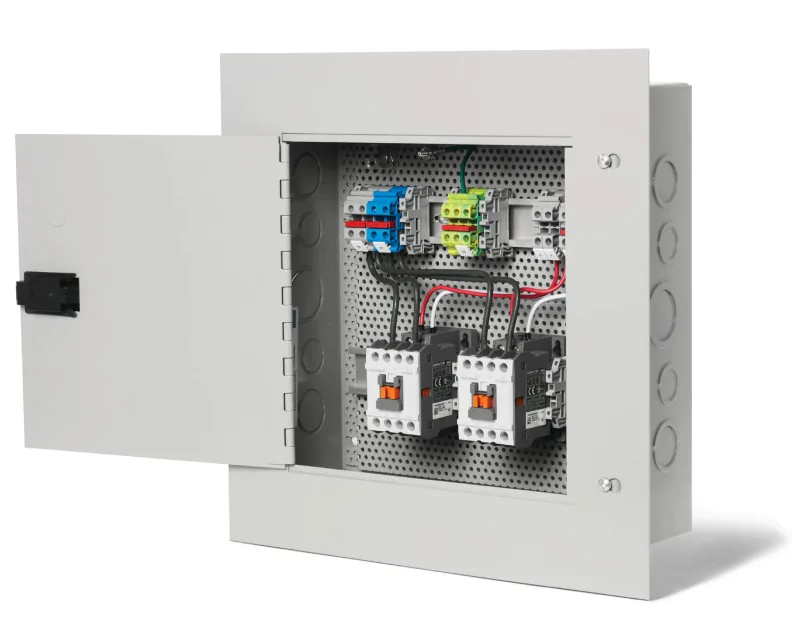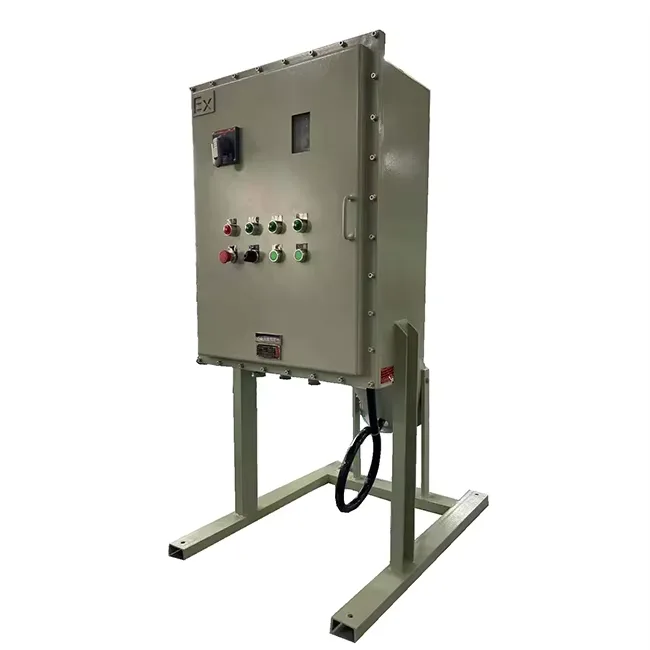A 저전압 패널 일반적으로 1,000V AC 또는 1,500V DC 미만의 전압에서 전력을 관리하고 분배하는 배전반입니다. 이 패널은 주전원에서 주택, 상업 및 산업 시설 전반의 다양한 회로, 부하 및 장비로 전력을 안전하게 분배하는 중앙 제어 지점 역할을 합니다.
저전압 패널은 회로 차단기, 퓨즈, 모니터링 장치를 통해 전기 시스템을 보호하는 동시에 조명, 콘센트, HVAC 시스템 및 기타 전기 장비에 체계적인 전력 분배를 제공하는 필수적인 안전 구성 요소입니다.
저전압 패널과 고전압 패널의 차이점은 무엇입니까?
저전압 패널과 고전압 패널의 차이점을 이해하는 것은 전기 안전과 적절한 시스템 설계에 매우 중요합니다.
저전압 패널과 고전압 패널 비교
| 기능 | 저전압 패널 | 고전압 패널 |
|---|---|---|
| 전압 범위 | 1,000V AC / 1,500V DC 이하 | 1,000V AC / 1,500V DC 이상 |
| 일반적인 애플리케이션 | 주거용, 소규모 상업용, 제어 시스템 | 산업 플랜트, 유틸리티 변전소 |
| 안전 요구 사항 | 표준 전기 안전 관행 | 특수 고전압 안전 프로토콜 |
| 설치 복잡성 | 중간 - 자격을 갖춘 전기 기술자 | 높음 - 전문 기술자 필요 |
| 비용 | 초기 비용 및 유지 관리 비용 절감 | 초기 비용과 유지 관리 비용이 더 높음 |
| 공간 요구 사항 | 컴팩트형, 벽걸이형 또는 바닥형 | 더 넓은 면적, 특수화된 객실 |
| 아크 플래시 위험 | 낮은 에너지 수준 | 더 높은 에너지 수준, 특수 PPE 필요 |
저전압 패널의 핵심 구성 요소
저전압 패널에는 안전하고 안정적인 전력 분배를 보장하기 위해 함께 작동하는 여러 가지 중요한 구성 요소가 포함되어 있습니다.
필수 패널 구성 요소
1. 메인 브레이커 또는 메인 분리기
– 전체 패널에 대한 전원을 제어합니다.
– 비상 차단 기능 제공
– 패널의 총 전류 정격에 따라 크기가 결정됩니다.
2. 지점 회로 차단기
– 개별 회로를 보호합니다. 과전류
– 다양한 암페어로 제공 평가 (15A, 20A, 30A 등)
– 회로 과부하 발생 시 자동 트립
3. 버스 바
– 전력을 분배하는 구리 또는 알루미늄 도체
– 메인 버스는 서비스 입구에서 전력을 공급받습니다.
– 분기 버스는 개별 회로에 전력을 분배합니다.
4. 중립 및 접지 막대
– 전류에 대한 복귀 경로 제공
– 안전 및 적절한 회로 작동에 필수
– NEC 요구 사항에 따라 적절하게 결합되어야 함
5. 패널 인클로저
– 내부 구성 요소를 환경 요인으로부터 보호합니다.
– 전기 접촉에 대한 안전 장벽을 제공합니다.
– 다양한 환경에 맞는 다양한 NEMA 등급으로 제공
🔧 전문가 끝: 저전압 패널이 적절한 요구 사항을 충족하는지 항상 확인하십시오. NEMA 설치 환경에 따라 등급이 달라집니다. 실내 패널은 일반적으로 NEMA 1을 사용하지만, 실외 설치에는 NEMA 3R 이상의 등급이 필요합니다.
저전압 패널의 유형 및 분류
저전압 패널은 특정 용도와 설치 요구 사항에 맞게 설계된 다양한 구성으로 제공됩니다.
응용 프로그램별 패널 유형
| 패널 유형 | 전압 범위 | 일반적인 사용 | 주요 기능 |
|---|---|---|---|
| 주거 부하 센터 | 120/240V 단상 | 주택, 소형 아파트 | 20~40 회로, 플러그인 차단기 |
| 상업용 패널보드 | 120/208V 또는 277/480V 3상 | 사무실 건물, 소매점 | 30-84 회로, 볼트온 차단기 |
| 산업용 제어 패널 | 24V-600V 직류/교류 | 제조, 자동화 | 맞춤형 구성, 모니터링 시스템 |
| 모터 제어 센터(MCC) | 208V-600V 3상 | 산업용 모터 | 가변 주파수 드라이브, 스타터 |
| 배전반 | 120V-600V | 대규모 시설 | 높은 전류 정격, 다중 피더 |
구조별 패널 분류
표면 장착 패널
– 벽면에 설치
– 유지관리를 위한 더 쉬운 접근
– 상업적 응용 프로그램에서 일반적임
플러시 장착(매립형) 패널
– 벽체 내부에 설치됨
– 외관이 깔끔하고 공간 절약
– 주거 시설에서 인기 있음
독립형 패널
– 바닥 장착형 장치
– 더 높은 용량의 애플리케이션
– 산업용 및 대규모 상업용
저전압 패널의 응용 프로그램 및 사용 사례
저전압 패널은 주거, 상업, 산업 분야에서 다양한 용도로 사용됩니다.
주거용 애플리케이션
주요 기능:
– 공공 서비스에서 가정 회로로 전력을 분배합니다.
– 조명 및 콘센트 회로 보호
– 주요 가전제품(온수기, HVAC 등) 제어
- 제공하다 GFCI와 AFCI 코드에서 요구하는 보호
일반적인 주거용 패널 크기:
– 100암페어 서비스: 소규모 주택, 기본 전기 요구 사항
– 200암페어 서비스: 표준 현대 주택
– 400암페어 서비스: 광범위한 전기 시스템을 갖춘 대형 주택
상업용 애플리케이션
사무실 건물:
– 층 및 세입자 공간에 대한 전력 분배
– 조명 제어 시스템
– HVAC 장비 전원
– 비상 조명 회로
소매 시설:
– 매장 조명 및 디스플레이 전원
– POS 시스템 회로
– 보안 시스템 전원
– 냉장 장비 회로
산업 애플리케이션
제조 시설:
– 모터 제어 및 전력 분배
– 프로세스 제어 시스템 전원
– 안전 시스템 회로
– 계측 및 모니터링 장비
데이터 센터:
– 서버 랙 전원 분배
– UPS 시스템 통합
– 환경 제어 전원
– 네트워크 장비 회로
⚠다 안전 경고: 모든 저전압 패널 설치는 다음을 준수해야 합니다. 국가 전기 규정(NEC) 제408조 지역 전기 규정을 준수해야 합니다. 자격을 갖춘 면허를 소지한 전기 기술자만 패널 설치 또는 개조 작업을 수행해야 합니다.
적합한 저전압 패널을 선택하는 방법
적절한 저전압 패널을 선택하려면 몇 가지 중요한 요소를 신중하게 고려해야 합니다.
선택 기준 체크리스트
1. 전기 부하 요구 사항
– 총 연결 부하를 암페어로 계산합니다.
– 향후 확장 요구 사항 고려(25-30% 용량 추가)
– 전압 및 위상 요구 사항 결정
– 단락 전류 정격 평가
2. 환경 조건
– 실내 설치 대 실외 설치
– 온도 및 습도 고려 사항
– 부식성 분위기 요구 사항
– 지진 및 진동 요인
3. 코드 준수 요구 사항
– NEC 제408조(스위치보드 및 패널보드)
– 지역 전기 규정 수정
– UL 67(패널보드) 인증
– NEMA 표준 준수
4. 물리적 공간 제약
– 설치 가능 공간
– 필수 작업 허가(NEC 110.26)
– 마운팅 구성 기본 설정
– 향후 접근성 요구 사항
패널 크기 가이드
| 응용 프로그램 | 권장 전류 | 일반적인 회로 수 |
|---|---|---|
| 소규모 거주지 | 100-150A | 20~30회 회로 |
| 스탠다드 홈 | 200A | 30-40 회로 |
| 대형 주택 | 300-400A | 40~60회로 |
| 소규모 상업 | 225-400A | 30~50회 회로 |
| 대형 상업용 | 600-1200A | 50-84 회로 |
🔧 전문가 끝: 적절한 방열 및 규정 준수를 위해 80% 패널의 정격 용량을 항상 고려하십시오. 200A 패널은 연결된 부하의 160A를 초과해서는 안 됩니다.
설치 및 안전 고려 사항
저전압 패널을 올바르게 설치하는 것은 안전, 규정 준수, 안정적인 작동에 매우 중요합니다.
사전 설치 요구 사항
1. 설계 및 허가
– 필요한 전기 허가를 받으세요
– 완전한 부하 계산 및 패널 일정
– 유틸리티 서비스 요구 사항 확인
– 필요한 작업 허가 계획
2. 현장 준비
– 적절한 구조적 지지를 확보하세요
– 환경 조건 확인
– 케이블 라우팅 및 접근 계획
– 다른 건물 시스템과 조정
설치 안전 요구 사항
작업 허가 요구 사항(NEC 110.26):
– 앞쪽: 최소 3피트의 깨끗한 작업 공간
– 너비: 패널 너비 또는 최소 30인치 중 더 큰 폭
– 키: 바닥이나 플랫폼으로부터 6.5피트
– 전용 공간: 패널 위부터 구조 천장까지의 영역
접지 및 접합 요구 사항:
– 메인 본딩 점퍼 설치
– 장비 접지 도체 연결
– 중성선과 접지선 분리(서브패널용)
– 접지 전극 도체 크기
⚠다 중요 안전 경고: 적절한 전기 교육 및 면허 없이 저전압 패널을 설치, 개조 또는 정비하려고 하지 마십시오. 전기 작업은 감전, 감전, 화재 및 사망의 심각한 위험을 초래합니다.
유지 관리 및 문제 해결
정기적인 유지관리를 통해 저전압 패널의 안전하고 안정적인 작동이 보장되고 장비 수명이 연장됩니다.
정기 유지 관리 일정
월별 검사:
– 과열 징후에 대한 시각적 검사
– 느슨한 연결이나 손상된 구성 요소를 확인하십시오.
– 패널 도어 닫힘 및 잠금 작동 확인
– 비정상적인 상황을 문서화합니다.
연간 전문 유지 관리:
– 연결부의 열화상 검사
– 모든 연결부의 토크 검증
– 절연 저항 시험
– 아크 플래시 위험 평가 업데이트
일반적인 문제 및 해결책
| 문제 | 가능한 원인 | 전문 솔루션 |
|---|---|---|
| 잦은 회로 차단기 트립 | 과부하된 회로, 결함 있는 장비 | 부하 분석, 회로 재구성 |
| 패널 과열 | 느슨한 연결, 과부하 | 연결 조임, 부하 재분배 |
| 전압 변동 | 공공 서비스 문제, 연결 불량 | 공공 서비스 조정, 연결 수리 |
| 부식/산화 | 환경 노출 | 구성 요소 교체, 인클로저 업그레이드 |
🔧 전문가 끝: 안전 위험이 발생하기 전에 열화상 검사를 통해 과열 지점을 파악하기 위해 매년 일정을 정하십시오. 느슨한 연결은 위험한 아크 플래시 상황을 초래할 수 있습니다.
규정 준수 및 표준
저전압 패널은 안전과 적절한 작동을 보장하기 위해 수많은 규정과 표준을 준수해야 합니다.
키 코드 요구 사항
국가 전기 규정(NEC) 조항:
– 제408조: 스위치보드 및 패널보드
– 제110조: 전기 설비 요구 사항
– 제240조: 과전류 보호
– 제250조: 접지 및 본딩
업계 표준:
– UL 67: 패널보드 표준
– UL 891: 스위치보드 표준
– NEMA PB 1: 패널보드 표준
– IEEE 표준: 설치 및 테스트 요구 사항
인증 요구 사항
패널 인증:
– UL 인증 구성 요소 및 조립품
– 캐나다 설비에 대한 CSA 인증
– NRTL(Nationally Recognized Testing Laboratory) 승인
– 관할권을 가진 지방 당국(AHJ) 승인
자주 묻는 질문
패널보드와 스위치보드의 차이점은 무엇인가요?
분전반은 일반적으로 1,200암페어 이하로 정격화되며 플러그인 또는 볼트온 회로 차단기를 사용합니다. 배전반은 1,200암페어 이상으로 정격화되며, 맞춤 조립된 고정형 스위치와 회로 차단기를 개별적으로 장착합니다.
저전압 패널은 얼마나 자주 검사해야 합니까?
매월 육안 검사를 실시하고, 매년 종합적인 전문가 검사를 받아야 합니다. 사용 빈도가 높은 산업용 패널은 6개월마다 더 자주 유지관리가 필요할 수 있습니다.
기존 저전압 패널에 회로를 추가할 수 있나요?
네, 패널에 사용 가능한 공간과 용량이 있다면 가능합니다. 단, 이 작업은 반드시 면허를 소지한 전기 기술자가 수행해야 하며, 일반적으로 전기 관련 허가 및 검사가 필요합니다.
저전압 패널이 고장나는 원인은 무엇입니까?
일반적인 원인으로는 열이 축적되는 느슨한 연결, 과전류 상태, 습기나 부식과 같은 환경적 요인, 노후화된 부품의 성능 저하 등이 있습니다.
저전압 패널을 교체해야 하는지 어떻게 알 수 있나요?
징후로는 차단기가 자주 작동하는 경우, 눈에 띄는 부식이나 손상, 패널이 25~30년 이상 된 경우, 현재 부하에 대한 용량이 부족한 경우, 또는 패널이 현재 안전 규정을 충족하지 못하는 경우 등이 있습니다.
저전압 패널의 일반적인 수명은 얼마입니까?
잘 관리된 패널은 일반적으로 25~40년 동안 사용할 수 있습니다. 그러나 혹독한 환경이나 잦은 사용으로 인해 패널이 손상될 경우 더 빨리 교체해야 할 수도 있습니다.
저전압 패널 유지관리에 특수도구가 필요합니까?
네, 적절한 유지관리를 위해서는 적외선 온도계, 토크 렌치, 절연 테스터, 전기 작업을 위한 적절한 개인 보호 장비(PPE)가 필요합니다.
날씨가 저전압 패널 성능에 영향을 미칠 수 있나요?
네, 극한 온도, 습도 및 수분은 패널 성능에 영향을 미칠 수 있습니다. 실외용 패널은 적절한 NEMA 등급이 요구되며 추가적인 환경 보호가 필요할 수 있습니다.
빠른 참조 가이드
패널 선택 체크리스트
- 총 전기 부하 요구 사항 계산
- 전압 및 위상 요구 사항 결정
- 사용 가능한 설치 공간 확인
- 환경 조건을 확인하세요
- 코드 준수 요구 사항 확인
- 향후 확장 요구 사항에 대한 계획
- 필요한 허가 및 승인을 받으세요
안전 알림
- 패널 작업 전에 항상 전원을 끄십시오.
- 전기 작업에는 적절한 PPE를 사용하세요
- 필요한 작업 허가를 유지하세요
- 작업을 시작하기 전에 회로를 테스트하세요
- 잠금/태그아웃 절차를 따르세요
- 자격을 갖춘 전기 기술자만 작업을 수행하도록 허용하십시오.
비상 절차
- 전기 비상 상황: 메인 차단기를 즉시 끄세요
- 불: C급 소화기만 사용하세요
- 전기 충격: 911에 전화하세요. 전원이 꺼질 때까지 피해자를 만지지 마세요.
- 아크 플래시: 지역을 대피하고 응급 서비스에 전화하세요





